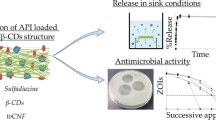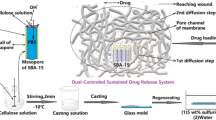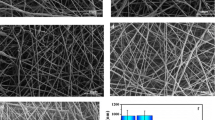Abstract
The biocompatibility and very high specific area of cellulose nanofibrils (CNF) are properties of high interest for the development of active substrates for new medical device development. Enzyme pretreated CNF (CNF-e) can be self-organized into nanostructured membranes that are suitable for active principle ingredients (API) encapsulation through adsorption phenomena. In addition, tunable surface chemistry of CNF-e, allow for covalent immobilization of API. In this work, ciprofloxacin is integrated to CNF-e membranes according to two different strategies. The first one relies only on adsorption mechanisms; ciprofloxacin is encapsulated in the bulk before the membrane formation by solvent casting. The influence of the membrane properties and preparation parameters such as grammage, thickness and drying technique, are assessed with water uptake measurements and API release experiments. The second strategy deals with the covalent immobilization of ciprofloxacin directly onto CNF-e membrane. The two kinds of membranes are then compared in terms of antibacterial activity, in both static and dynamic conditions. Thick CNF-e membranes loaded with adsorbed ciprofloxacin that were overdried (2 h, 150 °C) prove to be more resistant in liquid medium and present a more prolonged drug release. However, these membranes rapidly lost their antibacterial activity, while CNF-e membranes with covalently immobilized ciprofloxacin remain contact active for several days. These 100% CNF active nanostructured membranes can be used as new wound dressing for topical application.
Graphic abstract











Similar content being viewed by others
References
Abitbol T, Rivkin A, Cao Y, Nevo Y, Abraham E, Ben-Shalom T, Lapidot S, Shoseyov O (2016) Nanocellulose, a tiny fiber with huge applications. Curr Opin Biotechnol 39:76–88. https://doi.org/10.1016/j.copbio.2016.01.002
Appelbaum PC, Hunter PA (2000) The fluoroquinolone antibacterials: past, present and future perspectives. Int J Antimicrob Agents 16:5–15. https://doi.org/10.1016/S0924-8579(00)00192-8
Aulin C, Gällstedt M, Lindström T (2010) Oxygen and oil barrier properties of microfibrillated cellulose films and coatings. Cellulose 17:559–574. https://doi.org/10.1007/s10570-009-9393-y
Bardet R, Bras J (2014) Cellulose nanofibers and their use in paper industry. In: Materials and energy. World Scientific, pp 207–232. https://doi.org/10.1142/9789814566469_0013
Basu A, Lindh J, Ålander E, Strømme M, Ferraz N (2017) On the use of ion-crosslinked nanocellulose hydrogels for wound healing solutions: physicochemical properties and application-oriented biocompatibility studies. Carbohydr Polym 174:299–308. https://doi.org/10.1016/j.carbpol.2017.06.073
Bober P, Liu J, Mikkonen KS, Ihalainen P, Pesonen M, Plumed-Ferrer C, von Wright A, Lindfors T, Xu C, Latonen R-M (2014) Biocomposites of nanofibrillated cellulose, polypyrrole, and silver nanoparticles with electroconductive and antimicrobial properties. Biomacromol 15:3655–3663. https://doi.org/10.1021/bm500939x
Dow G, Browne A, Sibbald RG (1999) Infection in chronic wounds: controversies in diagnosis and treatment. Ostomy Wound Manag 45:23–27, 29–40; quiz 41–2.
Dufresne A (2017) Nanocellulose. De Gruyter, Berlin, Boston, From nature to high performance tailored materials. https://doi.org/10.1515/9783110480412
Dufresne A, Thomas S, Pothan LA (2013) Biopolymer nanocomposites: processing, properties, and applications. Wiley, Hoboken
Henriksson M, Berglund LA, Isaksson P, Lindström T, Nishino T (2008) Cellulose nanopaper structures of high toughness. Biomacromolecules 9:1579–1585. https://doi.org/10.1021/bm800038n
Herbold BA, Brendler-Schwaab SY, Ahr HJ (2001) Ciprofloxacin: in vivo genotoxicity studies. Mutat Res Genet Toxicol Environ Mutagenesis 498:193–205. https://doi.org/10.1016/S1383-5718(01)00275-3
Hoang Thi TH, Chai F, Leprêtre S, Blanchemain N, Martel B, Siepmann F, Hildebrand HF, Siepmann J, Flament MP (2010) Bone implants modified with cyclodextrin: Study of drug release in bulk fluid and into agarose gel. Int J Pharm 400:74–85. https://doi.org/10.1016/j.ijpharm.2010.08.035
Hoeng F, Denneulin A, Bras J (2016) Use of nanocellulose in printed electronics: a review. Nanoscale 8:13131–13154. https://doi.org/10.1039/C6NR03054H
Hooper DC, Wolfson JF (1991) Fluoroquinolone antimicrobial agents. N Engl J Med 11:384–394
Jorfi M, Foster EJ (2014) Recent advances in nanocellulose for biomedical applications. J Appl Polym Sci. https://doi.org/10.1002/app.41719
Kargarzadeh H, Mariano M, Gopakumar D, Ahmad I, Thomas S, Dufresne A, Huang J, Lin N (2018) Advances in cellulose nanomaterials. Cellulose 25:2151–2189. https://doi.org/10.1007/s10570-018-1723-5
Klemm D, Kramer F, Moritz S, Lindström T, Ankerfors M, Gray D, Dorris A (2011) Nanocelluloses: a new family of nature-based materials. Angew Chem Int Ed 50:5438–5466. https://doi.org/10.1002/anie.201001273
Kolakovic R, Peltonen L, Laukkanen A, Hirvonen J, Laaksonen T (2012) Nanofibrillar cellulose films for controlled drug delivery. Eur J Pharm Biopharm 82:308–315. https://doi.org/10.1016/j.ejpb.2012.06.011
Laurén P (2018) Biomedical applications of nanofibrillar cellulose. Ph.D. thesis
Lavoine N, Desloges I, Bras J (2014a) Microfibrillated cellulose coatings as new release systems for active packaging. Carbohydr Polym 103:528–537
Lavoine N, Desloges I, Sillard C, Bras J (2014b) Controlled release and long-term antibacterial activity of chlorhexidine digluconate through the nanoporous network of microfibrillated cellulose. Cellulose 21:4429–4442. https://doi.org/10.1007/s10570-014-0392-2
Lavoine N, Tabary N, Desloges I, Martel B, Bras J (2014c) Controlled release of chlorhexidine digluconate using β-cyclodextrin and microfibrillated cellulose. Colloids Surf B 121:196–205
Lavoine N, Guillard V, Desloges I, Gontard N, Bras J (2016) Active bio-based food-packaging: Diffusion and release of active substances through and from cellulose nanofiber coating toward food-packaging design. Carbohydr Polym 149:40–50. https://doi.org/10.1016/j.carbpol.2016.04.048
Lee K-Y (2018) Nanocellulose and sustainability: production, properties, applications, and case studies
Lin N, Dufresne A (2014) Nanocellulose in biomedicine: Current status and future prospect. Eur Polym J 59:302–325. https://doi.org/10.1016/j.eurpolymj.2014.07.025
Markham PN (1999) Inhibition of the emergence of ciprofloxacin resistance in streptococcus pneumoniae by the multidrug efflux inhibitor reserpine 2
Nechyporchuk O, Belgacem MN, Bras J (2016) Production of cellulose nanofibrils: a review of recent advances. Ind Crops Prod. https://doi.org/10.1016/j.indcrop.2016.02.016
Rol F, Belgacem MN, Gandini A, Bras J (2018) Recent advances in surface-modified cellulose nanofibrils. Prog Polym Sci. https://doi.org/10.1016/j.progpolymsci.2018.09.002
Saini S, Belgacem N, Mendes J, Elegir G, Bras J (2015) Contact antimicrobial surface obtained by chemical grafting of microfibrillated cellulose in aqueous solution limiting antibiotic release. ACS Appl Mater Interfaces 7:18076–18085. https://doi.org/10.1021/acsami.5b04938
Saini S, Sillard CB, Belgacem MN, Bras J (2016a) Nisin anchored cellulose nanofiber for long term antimicrobial active food packaging. RSC Adv 6(15):12422–12430
Saini S, Belgacem MN, Salon MCB, Bras J (2016b) Non leaching biomimetic antimicrobial surfaces via surface functionalisation of cellulose nanofibers with aminosilane. Cellulose 23:1–16
Smyth M (2017) Nanocellulose based materials for Cell Culture (phdthesis). Université Grenoble Alpes, Grenoble
Smyth M, Fournier C, Driemeier C, Picart C, Foster EJ, Bras J (2017) Tunable structural and mechanical properties of cellulose nanofiber substrates in aqueous conditions for stem cell culture. Biomacromolecules 18:2034–2044. https://doi.org/10.1021/acs.biomac.7b00209
Sukul M, Ventura RD, Bae SH, Choi HJ, Lee SY, Lee BT (2017) Plant-derived oxidized nanofibrillar cellulose-chitosan composite as an absorbable hemostat. Mater Lett 197:150–155. https://doi.org/10.1016/j.matlet.2017.03.102
Acknowledgments
The authors would like to thank Clémentine Darpentigny from LGP2/CERMAV/CEA Leti for part of the successive antibacterial activity testing. Authors would like to thank the Agence Nationale de la Recherche and more especially CELLICAL Project (Grant ANR-15-CE08-0033) for the Ph.D. funding. LGP2 is part of the LabEx Tec 21 (Investissements d’Avenir—Grant Agreement No. ANR-11-LABX-0030) and of PolyNat Carnot Institute (Investissements d’Avenir—Grant Agreement No. ANR-16-CARN-0025-01).
Author information
Authors and Affiliations
Corresponding author
Ethics declarations
Conflict of interest
The authors declare that they have no conflict of interest.
Additional information
Publisher's Note
Springer Nature remains neutral with regard to jurisdictional claims in published maps and institutional affiliations.
Rights and permissions
About this article
Cite this article
Durand, H., Jaouen, P., Faure, E. et al. Pure cellulose nanofibrils membranes loaded with ciprofloxacin for drug release and antibacterial activity. Cellulose 27, 7037–7052 (2020). https://doi.org/10.1007/s10570-020-03231-5
Received:
Accepted:
Published:
Issue Date:
DOI: https://doi.org/10.1007/s10570-020-03231-5




